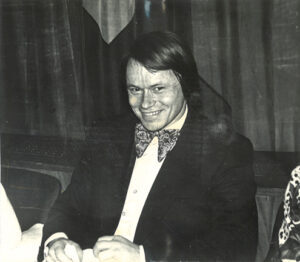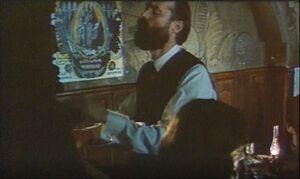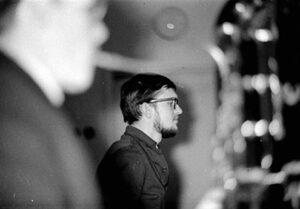TALLINNFILMI MUUSIKATOIMETAJA IGAPÄEVATÖÖST II
Aprill, 2022Intervjuu Alo Põldmäega
(Algus TMK 2022, nr 3)
Kas Eestis võiks olla filmimuusika loomise õpe?
Muidugi! See on niivõrd spetsiifiline muusikaala; keegi pole kuskil meile seda õpetanud. Kõik need heliloojad, kes näiteks minu töötamise ajalgi tulid, nad õppisid ju kõik töö käigus seda, mida oleks võinud õppida kümme või kakskümmend aastat varem. Omad vitsad said kõik, alates kõige suurematest nimedest, Tambergist ja Pärdist. Mõni sai väiksemad vitsad ja mõni suuremad.
Su muusika võidi lõigata prauhti pooleks, jätta välja, asendada näiteks linnuhäältega jne?
Kui palju kordi oli nii, et originaalmuusika polnud õige pikkusega, helilooja pidi muusikat juurde kirjutama. Mina tegin muusikat peamiselt dokumentaalfilmidele, sealgi salvestasin varuga. Seda oleks pidanud tegelikult honoreerima. Aga lepingutes oli kirjas: honoreeritud on filmi minev muusika. Siis pidi muusika pikkusega ühtelugu laveerima. Mõnikord helilooja muusikat peaaegu ei kasutatudki, vahele pandi kujundusmuusikat. Arvo Pärt tegi aga sekundi täpsusega ja tal klappis. Tema ei kirjutanud varumuusikat, see oleks olnud liigne jõu raiskamine.
Aga kuskil võiks ju õpetada niisuguste elementaarsete asjadega operatiivselt ümber käima. Minule oli jäänud mulje, et muusika peab kogu aeg uuenema. No ei pea uuenema! Juhtmotiivid, leitmotiivid… Juba vana Wagner ütles, et ligi pool muusikamaailma seisab juhtmotiivide peal. Ülo Vinter näiteks oli väga osav ja lisaks ka vaimukas. Tema tegi muusikat multifilmidele ja rohkem telefilmidele. Tema kuulsad tööd on juba hittfilmides „Noor pensionär” ja „Siin me oleme”. Ta töötas äärmiselt operatiivselt. Võttis mingi kena meloodiakese ja sättis seda erinevas valguses — ühtpidi ja teistpidi, jupikaupa ja natuke pikemalt. Ja see töötas.

Helilooja Ülo Vinter (1924–2000) on teinud muu hulgas muusika hittfilmidele „Mehed ei nuta”, „Siin me oleme” ja „Noor pensionär”. ERRi foto
Aga huvitav, kas siis Pärt töötas ka stopperi ja nende meetrite, tabelite ja kõige sellisega?
Loomulikult. Pärdil olid suured tabelid. Mul on isegi üks „Navigaator Pirxi” eksplikatsioon. Selle muusika salvestamise juures ma viibisin, see tehti sümfooniaorkestriga. Suurejooneline muusika. Mõni ajas ju lihtsamalt läbi: motiivikene siin ja motiivikene seal, pikad akordid jne. Paisutatud akordidega annab paljutki teha. Käisin äsja vaatamas filmi „Eesti matus”, heliloojaks Arian Levin. Kui operatiivselt on seal kasutatud pikka akordi, kui asi hakkas dramaatiliseks minema! Või siis „Tõde ja õigus” (helilooja Mihkel Zilmer), seal on ka palju akorde. Kontrabasside abil on seal suurt rõhku pandud madalale registrile. Oleks keegi seda meile õpetanud! Meie kirjutasime kogu aeg uusi lõike. Uusi, et oleks huvitav. Et oleks just nagu huvitav. Aga seda ei ole ju filmis kogu aeg vaja… Sellist asja peaks õpetama lausa eraldi ainena.
Ma küsin veel Pärdi kohta. Tal on see kuulus „vaikiv periood”. Aga „Navigaator Pirxis” on ju massiivne muusika… ja siis on tal veel „Ukuaru”, „Värvilised unenäod”, „Briljandid proletariaadi diktatuurile” ja mitmed animafilmid. Need justkui ei väärikski mainimist, justkui polekski looming. Kuigi, jah, viimasel ajal võib Arvo Pärdi keskuse kodulehelt nende kohta siiski infot saada. Tegelikult tegi ta ju sel perioodil väga palju filmimuusikat, aga see justkui ei mahu sinna narratiivi.
Ei mahu. Täna, just enne sinu tulekut ma mõtlesin, et vaatan täpselt järele, millal see „Navigaator Pirx” välja tuli. Ma võin aastaga eksida, aga see oli võib-olla 1978.
Jah, 1978 oli esilinastus.
Võtan kätte 2007. aastal ilmunud „Eesti muusika biograafilise leksikoni” ja seal Pärdi loomingu hulgas filme üldse ei olegi! Nii suur osa Pärdi heliloomingust on sealt puudu! Kust me siis saame teada, et ta on teinud nii palju filmimuusikat?
Üsna paljudele tuleb see üllatusena.
See on lihtsalt viga. Ma tegin sellest juttu artikli autori Saale Karedaga. Ta väitis, et see osa Pärdi loomingust ei ole sihilikult välja jäetud, aga eeskujuks on olnud Universal Editioni nimekiri.

Arvo Pärdi originaalmuusika eksplikatsioon filmile „Briljandid proletariaadi diktatuurile”, 22. II 1974. APK 9-3.5
See on hoiak, et see kõik on lihtsalt nagu taustaks. Näiteks Eino Tamberg ütleb ühes intervjuus, et tegi mõnda aega filmimuusikat ja tuli siis „päris” muusika juurde tagasi. (Minu jutumärgid — A. R. V.)
See tuleb võib-olla sellest, et helilooja ei ole filmi puhul esiplaanil. Näitlejad, süžee, faabula — need on esiplaanil. Muusika aitab pigem kaasa. Helilooja siis leiab, et tema ei ole seal peremees, tema on nagu abivahend. See võib mängida rolli. Mul on hästi meeles, kuidas „Navigaator Pirx” algab… kui lennuk tuleb. Suurejoonelise sümfoonilise muusikaga tuleb suur lennuk lennuväljale! Terve muusikaline stseen ja kui ilus muusika! Ja kui täpselt on seal muusika eksplikatsioon paigas. Mul on kuskil tallel paar sellist eksplikatsiooni, kunagi ma kingin need muuseumile. Seal on täpselt, sekundi pealt kirjas: lennuk tuleb siit, läheb sealt üle, läheb lennuväljale, 22. sekund — peatub. Nii detailideni välja, viie sekundi täpsusega: et kui kaugele see lennuk läheb ja et muusika lõpeb „siin” ära.
See eeldab ülipõhjalikku dramaturgiatunnetust.
No ja siis on Pärdil ju veel multifilmid, niisugused toredad. Sa mainisid ennist mängufilmi „Värvilised unenäod”. Kui ma stuudiosse tööle tulin, oli see üks esimesi mängufilme, millega kokku puutusin.
Lavastaja Jaan Tooming oma tippvormis.
Missugune fantaasiafilm! Ma tahaksin seda kunagi uuesti näha. Tooming andis Pärdile muusika tegemisel täiesti vaba voli. See on täiskasvanute film, aga seal tegutsevad lapsed. See on film lastest. Nende mängud… See on nii osavalt tehtud ja Pärt oli sellest nii vaimustatud. Ta käis salvestamas. Enn Säde käis seal… ja kes seal kõik veel käisid… Pärdile tuli ükskord idee, et lähme ja taome neid palke, nagu lapsed. Sündis palkide muusika. Nii originaalne! Ma ei mäleta, et seal oleks mingit orkestrit olnud; mäng käis naturaalsete helidega. Täiesti ennekuulmatu! Näed, ma räägin sellest siin vaimustusega veel 48 aastat hiljem.
Huvitav, kas sellele tehti ka partituur?
See on hea küsimus, seda ma ei mäleta. Seal mängiti ka meloodiaid, aga enamus oli nn konkreetne muusika… igasuguste klõbinatega. Näiteks lapsed mängisid pudelitega. Seal segunevad fantaasia ja unenägu. Väga huvitav film.

Fotol musitseerivad Arvo Pärt ja Jaan Tooming kuivanud puul mängufilmile „Värvilised unenäod”. Arvo Iho foto
Lisaks kõigele kõlab seal veel gamelani-muusika (indoneesia päritolu löökpill). Selle muusika plaadi olevat Tooming kusagilt kätte saanud ja stuudiosse toonud, nagu meenutab helirežissöör Enn Säde. See mõjub eksootiliselt ka praegu filmi üle vaadates. Aga Veljo Tormis on kirjutanud ju samuti palju filmimuusikat. Ka sellest on üsna vähe räägitud.
Minu ajal tegi Tormis ühe mitmeseerialise filmi muusika. See oli see Karasjovi film, mis ära keelati. Tormisel läks selle peale suur aur. Ja see tuli välja alles Eesti vabariigi ajal — mina polegi seda tervikuna näinud.
„Lindpriid”, 1971. Tormisel on seal muide ka märkimisväärne näitlejatöö!
Seda püüti korduvalt ikkagi näidata, aga ideoloogilised takistused olid nii suured. Aga kuna Kruusemendi „Kevade” (1969) oli Tormisel suur õnnestumine, siis tulid järgmised Lutsu ekraniseeringud („Suvi” ja „Sügis”) samuti temale.

Veljo Tormis on ligikaudu 40 dokumentaal- ja mängufilmi helilooja, lisaks on tema kontsertmuusikat kasutatud kümnetes eesti filmides. Fotol on Veljo Tormis näitlejana Vladimir Karassev-Orgussaare (filmimise aegu Vladimir Karasjov) mängufilmis „Lindpriid” (Eesti Telefilm, 1971), millele ta ka muusika kirjutas.
Rein Marani filmifoto
Tänapäeval on selles mõttes mugav, et arvutiga on võimalik mingil moel maha mängida seda, mida helilooja teeb või kuidas mõtleb. Ei pea kutsuma koori ja orkestrit salvestama, et siis öelda, et ei sobi…
Mõtte ja lähenemise ja selle, missugune on koosseis ja muusika üldine kõlapilt, saab jah anda enne arvutiga. Siin tuleb meelde selline mees nagu Andrei Volkonski, Peeter Volkonski isa.
Vene helilooja ja klavessinist… Ta pidi looma muusika „Viimsele reliikviale”?
Jah! Kuna ma olin siis ansamblis Collage, kutsuti mind ka lindistama. Andrei Volkonski oli teinud päris moodsa muusika ja see istunud režissöörile kohe mitte sugugi. Me tegime raadios tohutult kaua, tundide viisi salvestusi ja ainult üks suur õiendamine käis, et see ei ole mingi muusika…Ja see ei läinudki! See oli nii modernne muusika. Me rääkisime siin äsja, et filmimuusika puhul saab igasuguseid eksperimente teha. Jaan Räätsal on niisugust moodsat muusikat, Kuldar Singist rääkimata — lausa modernistide muusikaks võiks seda nimetada. Andrei Volkonski muusika oli sellest veel suur samm edasi. See oli umbes nagu tolleaegsed poola avangardistide asjad, sellised judinad ja sahinad ja ainult kriuksumised. Ja ma mäletan, kuidas režissöör Kromanov jooksis ringi ja oli jahmunud, et mis sealt tuleb. Tookord me olime väga hämmastunud, et nii kuulsa helilooja muusika… ja ei kõlba. Nii et kõik jäeti pooleli.

Andrei Volkonski oli üks silmapaistvamaid klavessiinimängijaid Nõukogude Liidus ning oluline vanamuusika propageerija, vanamuusikaansambli Madrigal asutaja. Lisaks veel ka helilooja. Kirjutas ülimodernse muusika filmile „Viimne reliikvia”, mis aga ei läinud kasutusse.
Bach Cantatas Website’i kuvanope
Kui see lint on alles, siis oleks selle leidmine praegu suur avastus.
Seiklusfilmile laulsime vokaaliga 12-toonis käike! Kuid me ju ei tea, milline oleks olnud lõpptulemus.
Üks intrigeeriv küsimus ka. Juba varane Hollywoodi kino kasutas immigrantidest heliloojate oskusi; globaalne on see valdkond olnud juba ammu enne, kui globaliseerumisest rääkima hakati. Tänapäeval tehakse palju koostööfilme ja levinud skeem on selline, et n-ö Eesti filmile, mis on kaastootmises, teeb originaalmuusika välismaalane. Filmimuusika on küllaltki universaalne nähtus. Aga mis oleks olnud, kui näiteks „Kevadele”, „Viimsele reliikviale”, „Nukitsamehele”, „Nipernaadile”, „Arabellale” ja „Ukuarule” oleksid omal ajal loonud muusika välismaalased? Mida meie kultuur oleks sellest võitnud või kaotanud? Teisiti küsides, kas meie muusikaloojatel on mingi ühine kohavaimu tunnetus?
Nõukogude ajal oli võimalik, et erandjuhtudel tuli väljastpoolt Eestit siia filmimuusikat tegema mõne teise liiduvabariigi helilooja. Sellise erandina meenub Helle Karise „Metsluiged” (1987), mille muusika tegi Leningradi helilooja Oleg Karavaitšuk. Välismaalt ei saanud toona aga keegi siia tulla, see ei tulnud kõne allagi.
Aga mängime selle mõttega edasi. Ütleme, et ka Nõukogude Liidu teised vabariigid, nii Läti, Leedu kui ka Venemaa on selles kontekstis nagu välismaa. Kas teiste liiduvabariikide heliloojate meile filmiheliloojaks kutsumine oli kuidagi raskendatud või seda lihtsalt ei tahetud teha?
Liidu piires oleks nende kutsumine kõne alla tulnud, aga väljastpoolt, näiteks Soomest, mitte. Isegi Saksa Demokraatlikust Vabariigist või Ungarist vaevalt. Selle peale üldse ei tuldudki, sest meil endal oli ju nii palju heliloojaid. Aga minul on igatahes väga kahju ühest heliloojast, Lembit Veevost, kes tegi suurepärast filmimuusikat. Kui tuli see uus laine — Tamberg, Rääts, Pärt, Sink —, siis tagasihoidliku loomuga Veevo, kes polnud filmimuusika osas sugugi kehvem helilooja, jäi kõrvale.

Lembit Veevo aastal 1986. Veevo tegi originaalmuusika Kaljo Kiisa seitsmele filmile: „Jääminek”, „Jäljed”, „Me olime kaheksateistkümneaastased”, „Keskpäevane praam”, „Hullumeelsus”, „Maaletulek”, „Metskannikesed”. Kiisk ja Veevo olid eakaaslased, mõlema elu oli nooruses seotud Ida-Virumaaga ning neid ühendas sõjakogemus. Kalju Suure foto
Vaatasin järele, tal on sellised filmid nagu „Metskannikesed” (1980), ,„Maaletulek” (1973), „Tuuline rand” (1971), „Hullumeelsus” (1968), „Keskpäevane praam” (1967), „Me olime kaheksateistkümneaastased” (1965), „Jäljed” (1963), „Jääminek” (1962).
Jah. Siin ongi näide sellest, et tuleb ise aktiivsust üles näidata ja asjadega kursis olla, endast märku anda. Veevo hoidis rohkem omaette ja jäigi kõrvale. See on väga eluline tõsiasi — kui sa ei osale mängus, siis jäädki kõrvale.
Isikuomadused mängivad suurt rolli. Kuid „Viimsel reliikvial” olekski ju olnud välismaalasest helilooja, kui Volkonski muusika oleks läbi läinud.
Võib, ma räägin „Viimse reliikvia” kohta ühe väikse loo. Olin vanasti päris kõva mägimatkaja. Käisime suurtel mägimatkadel ja olime Pamiiris aastal 1973, kui ma töötasin juba Tallinnfilmis. Pamiiris oli meil üks kõigi aegade võimsamaid matku, mille me lõpetasime Fedtšenko liustikul, sealses ilmajaamas. Teadlased tulevad sinna kohale aastaks ja talvituvad seal üle 4 200 meetri kõrgusel. Meie kui Eesti grupi auks korraldati filmiõhtu ja nad otsisid välja oma kõige populaarsema filmi. Selleks oli „Viimne reliikvia”!
Ja seal laulab Georg Ots neid laule, mitte Peeter Tooma, eks? Sest see film on ju ka vene keeles olemas, nagu toona tavaks oli.
Täpselt! Georg Ots, jah. Nad olid seda vaadanud ühe aasta jooksul oma kolmkümmend korda. Vaat, millist rolli on mänginud eesti filmid!
Aga ma tulen ikkagi selle hüpoteetilise olukorra juurde, kui meil oleks nt „Kevadele” teinud muusika mõni leedu helilooja või „Viimsele reliikviale” oleks laulud teinud mõni laulusepp Moskvast…
Oleks ju päris huvitav olnud. Kui kasutada sõna „huvitav”.
Aga nad ei oleks kindlasti olnud rahvuslikud.
See rahvuslik moment ikkagi mängib ja on olnud meie filmimuusikas oluline. Aga praegu on asi hoopis teine. Tol ajal peeti elementaarseks, et ikkagi oma helilooja teeb rahvusliku kallakuga filmi. See on nii kummaline, et nõukogude ajal tähtsustati rahvuslikkust rohkem kui praegu. Rahvaviisid olid au sees, ka mina käisin üliõpilasena neid kogumas. Heliloojatel-õppuritel oli see kohustuslik, aga kas praegu on niimoodi? Tähtsustati rahvaloomingut, samas oli ideoloogiline surve. Mingi selline vastuolu. Samas, tänu sellele sai ka võimalikuks selline filmimuusika nagu Tormisel. Tänu sellele sai oma rahvaviisid filmi sisse panna. Kui meie filmidele oleks muusika teinud mõni Leedu või Jugoslaavia helilooja, siis vaevalt ta oleks oma kohalikku rahvaviisi sisse pannud. Oleks mingi üleüldine filmimuusika. Selles mõttes ikkagi eelistati omi heliloojaid. Rahvuslikkuse seisukohalt on omade eelistamine ikkagi pluss.
Ma lugesin, et Tormis sai Moskvas oma õppejõult Vissarion Šebalinilt väga tugeva tõuke rahvamuusika kasutamiseks. Selles mõttes on see tüüpiline nõukogulik absurd, sisult sotsialistlik, vormilt rahvuslik, aga aitas sündida sellisel fenomenil nagu Tormis. Sotsialistlikkus jäi muidugi kõrvale.
Täiesti nõus!
Võib-olla oleks ta tahtnud kirjutada hoopis nagu näiteks Penderecki?
Jah. Me olime noored vihased poisid ja püüdsime instrumentaalmuusika peale üle minna. Rahvuslikkus tuli meile tegelikult varem, Peterburi konservatooriumist. Vaata, kuidas Rimski-Korsakov koolitas mitmeid eestlasi, Mart Saart ja Cyrillus Kreeki. Tuleb rahvaviis kuulajateni viia — ja Mart Saar võttis seda sõna-sõnalt. See oli juba vene traditsioonis sees, toodi Eestisse üle ja nõukogude ajal see jätkus. Muidugi natuke teistsugusel kujul.
Nõukogude aja algul sai meil siin sellest kibe kohustus. Bartóki mõjust Tormisele on ka räägitud — tema oli samuti rõhutanud, et tuleks uurida oma rahvaviise. Tubin, kes elas pärast sõda Rootsis, oleks ju võinud loobuda rahvaviisi kasutamisest, aga pigem läks vastupidi. Järelikult siis inimestel ikka on mingi kohavaimu tunnetus. Ei ole päris nii, et nipsutame sõrmi ja võtame Uus-Meremaalt kellegi muusikat tegema?
Tänapäeval me võime ju seda teha, aga kellele see kasulik on? Kultuurile on üldse ju paha, et kõik nivelleerub ja pole enam tippe ja süvikuid, kontraste. On vaid üks kindel mall. Muidugi on ka filmimuusika puhul oht, et teatud süntesaatoriklišeed pannakse lihtsalt käima, ühest filmist teise. Kes on selle liini peal, see teeb, ja teised lihtsalt ei pääse ligi, sest nad ei ole selles põhivoolus, ei ole sünkroonis selle vooluga. Nagu Andrei Volkonski siin. See on naljakas näide, ta sattus lihtsalt valesse kohta. Ta oli ju kuulus oma vanamuusika ansambliga. Ikka legend tol ajal.
Ma mõtlen, et kogu see 19.–20. sajandi lääne kunstmuusika areng, romantism ja tonaalsuse lagunemine ja modernismi tulek, millest nii palju räägitakse… Et kui see ära toimus, siis teise kanali kaudu kunstmuusika suunduski filmimuusikasse, sest romantism säilis eriti Hollywoodi kinos hästi kaua. Ta säilis isegi veel 1940-ndatel. Alles 1950-ndatel hakkasid džäss ja rokk sisse tulema. Tegelikult kestab romantism filmimuusikas siiani.
Hollywoodi filmidesse pole modernne muusika vist üldse jõudnud.
Kui, siis vähesel määral.
See on kummaline. Isegi eesti muusikasse on see ju päris teravalt sisse tulnud.
Paljud nõukogude heliloojad said filmimuusikas katsetada seda, mis oli kontsertmuusikas keelatud… Arvo Pärt on nimetanud seda loominguliseks laboratooriumiks.
1970-ndatel tuli juba vägagi moodsat helikeelt. Eino Tamberg kasutas seda, ja Jaan Rääts. Jah, siis sai moodsat muusikat filmis rakendada. Pärdi „Perpetuum Mobile” läks Varssavi sügisel kordamisele. Ülimodernne muusika tuleb kordamisele rahvusvahelisel festivalil! See on ju ennekuulmatu. Poola autoritegi teosed ei tulnud kordamisele. See modernsus jõudis ka filmimuusikasse, aga mitte muidugi nii eredal kujul. Seda ei olnud mõtet nii eredal kujul filmidesse panna, sest see jääb ju teksti varju ja tõuseb vaid üksikutes kohtades esile. See ongi filmimuusika spetsiifika. Võib-olla ei maksa vaeva näha, et selles stiilis teha, sest ta ei pääse mõjule. Aga ta võib pääseda mõjule ratsionaalsemate võtetega, näiteks mõne löökpilliga või kandlega, nagu dokumentaalfilmis… Ma mäletan, et ühele loodusfilmile tegi muusika loodusemees Mikk Sarv.

Mikk Sarv oma kuulsa okariiniga, mille ta pärast purunemist kokku liimis. Kuvatõmmis Miku videotervitusest Ugala teatrile 2015. aastal
Rein Marani filmidele, ühe-kahe pilliga… okariiniga jmt.
Ma väga imestasin selle üle. Ma olin ise ka salvestuste juures ja imestasin, et kuidas selline asi võimalik on.
Rein Marani loodusfilmid 1970. ja 1980. aastatest valmisid peamiselt Eesti Telefilmis ja põhiline muusika looja oli just Mikk Sarv, lisaks veel Henn Sarv ja Priit Pedajas. Selles muusikas on ürgne, folkloorne tunnetus, autentset eesti regilaulu viljeleva ansambli Hellero vaim. Marani filmograafia on muljetavaldav, viiekümne aasta jooksul on valminud üle seitsmekümne viie filmi. Valdavalt on need dokumentaalfilmid-loodusfilmid. Originaalmuusikat on neile teinud mitme põlvkonna esindajad, lisaks eelpool mainitutele veel Erkki-Sven Tüür, Urmas Sisask, Peeter Vähi ja Pärt Uusberg.
Tänan väga huvitava vestluse eest!
Vestelnud ARDO RAN VARRES



















